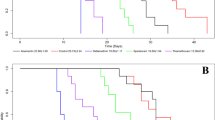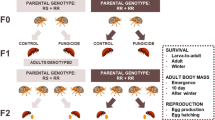Abstract
Organophosphate (OP) insecticides have been an effective control of several tephritid pests. Recently, OP resistance has been observed in various fly species from different localities. However, in cases where resistance to an OP is exhibited in the field, evaluations of the efficiency of trapping with lures mixed with the same OP toxicants have not been carried out. To address this, the trapping and killing efficiency of lures with OP toxicants was assessed for flies from lines of Bactrocera dorsalis exhibiting resistance and susceptibility to OP insecticides. Specifically, bioassays were conducted with males from susceptible, resistant, and revertant lines (derived by relaxation of selection in the resistant line). The trapping and killing efficiencies of traps containing concentrations of 5 or 2.5 % naled were assayed at different exposure times. For the susceptible line, the number of dead flies found inside and outside of the trap was significantly lower than that of the other two tested lines. The number of dead flies found outside was significantly lower for the 2.5 % naled concentration compared to that of the 5 % concentration. Additionally, an analysis of genotypes showed that in trapped males, the frequencies of alleles of the acetylcholinesterase gene associated with resistance were lower compared to males of the field population collected from the same localities. In conclusion, for cases where fly lines exhibit insecticide resistance, the use of toxicant lures laced with the same insecticides may severely impact trapping effectiveness and may result in further increases of the frequency of resistant genotypes in the population.




Similar content being viewed by others
References
Back EA, Pemberton CE (1918) The mediterranean fruit fly in Hawaii. US Dept Agr Bull No 536 118 pp
BCPC (2006) The pesticide manual. A world compendium 14th edn. BCPC (British Crop Protection Council) publications Hampshire
Benelli G, Daane KM, Canale A, Niu C-Y, Messing RH, Vargas RI (2014) Sexual communication and related behaviours in tephritidae - current knowledge and potential applications for integrated pest management. J Pest Sci. doi:10.1007/s10340-014-0577-3
Biondi A, Mommaerts V, Smagghe G, Vinuela E, Zappala L, Desneux N (2012) The non-target impact of spinosyns on beneficial arthropods. Pest Manag Sci 68(12):1523–1536. doi:10.1002/Ps.3396
Chambers DL, Fujimoto M, Ohinata K, Kashiwai S (1972) Treating tephritids diptera-tephritidae with attractants to enhance their effectiveness in sterile-release programs. J Econ Entomol 65(1):279–282
Chou M-Y, Haymer DS, Feng H-T, Mau RFL, Hsu J-C (2010) Potential for insecticide resistance in populations of Bactrocera dorsalis in Hawaii: spinosad susceptibility and molecular characterization of a gene associated with organophosphate resistance. Entomol Exp Appl 134(3):296–303
Daane KM, Johnson MW (2010) Olive fruit fly: managing an ancient pest in modern times. Annu Rev Entomol 55:151–169. doi:10.1146/annurev.ento.54.110807.090553
Dong YC, Wang ZJ, Clarke AR, Pereira R, Desneux N, Niu CY (2013) Pupal diapause development and termination is driven by low temperature chilling in Bactrocera minax. J Pest Sci 86(3):429–436. doi:10.1007/s10340-013-0493-y
Fitt GP (1981) The influence of age, nutrition and time of day on the responsiveness of male Dacus Opiliae to the synthetic lure, methyl eugenol. Entomol Exp Appl 30(1):83–90
Georghiou GP (1986) Insecticide resistance: the tephritidae next. Kolymbari, Crete
Gutierrez AP, Ponti L (2011) Assessing the invasive potential of the mediterranean fruit fly in California and Italy. Biol Invasion 13(12):2661–2676. doi:10.1007/s10530-011-9937-6
Han P, Wang X, Niu CY, Dong YC, Zhu JQ, Desneux N (2011) Population dynamics, phenology, and overwintering of Bactrocera dorsalis (Diptera: Tephritidae) in Hubei Province China. J Pest Sci 84(3):289–295. doi:10.1007/s10340-011-0363-4
Hawkes NJ, Janes RW, Hemingway J, Vontas J (2005) Detection of resistance-associated point mutations of organophosphate-insensitive acetylcholinesterase in the olive fruit fly, Bactrocera oleae (Gmelin). Pestic Biochem Physiol 81(3):154–163. doi:10.1016/j.pestbp.2004.11.003
Hee AKW, Tan KH (2004) Male sex pheromonal components derived from methyl eugenol in the hemolymph of the fruit fly Bactrocera papayae. J Chem Ecol 30(11):2127–2138. doi:10.1023/B:Joec.0000048778.02561.70
Hiramoto MK, Arita-Tsutsumi L, Jang E (2006) Test of effectiveness of newly formulated plastic matrix with methyl eugenol for monitoring Bactrocera dorsalis (Hendel) populations. Proc Hawaiian Entomol Soc 38:103–110
Hsu J-C, Feng H-T (2000) Insecticide susceptibility of the oriental fruit fly (Bactrocera dorsalis (Hendel)) (Diptera: Tephritidae) in Taiwan. Chin J Entomol 20:109–118
Hsu JC, Feng HT (2002) Susceptibility of melon fly (Bactrocera cucurbitae) and oriental fruit fly (B. dorsalis) to insecticides in Taiwan. Plant Prot Bull (Taichung) 44 (4): 303–315
Hsu JC, Feng HT, Wu WJ (2004) Resistance and synergistic effects of insecticides in Bactrocera dorsalis (Diptera: Tephritidae) in Taiwan. J Econ Entomol 97(5):1682–1688
Hsu JC, Haymer DS, Wu WJ, Feng HT (2006) Mutations in the acetylcholinesterase gene of Bactrocera dorsalis associated with resistance to organophosphorus insecticides. Insect Biochem Mol Biol 36(5):396–402
Hsu JC, Haymer DS, Chou MY, Feng HT, Chen HH, Huang YB, Mau RFL (2012) Monitoring resistance to spinosad in the melon fly (Bactrocera cucurbitae) in Hawaii and Taiwan. Sci World J. Artn 750576. doi:10.1100/2012/750576
Ito Y, Iwashashi O (1974) Ecological problems associated with an attempt to eradicate Dacus dorsais (Tephritidae; Diptera) from the southern islands of Japan with a recommendation on the use of sterile male technique. In: Proceedings Panel Vienna, IAEA, Vienna. The Sterile Insect Technique and its Field Applications pp 43–53
Jang EB (2011) Effectiveness of plastic matrix lures and traps against Bactrocera dorsalis and Bactrocera cucurbitae in Hawaii. J Appl Entomol 135(6):456–466. doi:10.1111/j.1439-0418.2010.01557.x
Jang EB, Ramsey A, Carvalho LA (2013) Performance of methyl eugenol plus matrix plus toxicant combinations under field conditions in Hawaii and California for trapping Bactrocera dorsalis (Diptera: Tephritidae). J Econ Entomol 106(2):727–734. doi:10.1603/Ec12371
Jin T, Zeng L, Lin YY, Lu YY, Liang GW (2011) Insecticide resistance of the oriental fruit fly, Bactrocera dorsalis (Hendel) (Diptera: Tephritidae), in Mainland China. Pest Manag Sci 67(3):370–376. doi:10.1002/Ps.2076
Kakani EG, Zygouridis NE, Tsoumani KT, Seraphides N, Zalom FG, Mathiopoulos KD (2010) Spinosad resistance development in wild olive fruit fly Bactrocera oleae (Diptera: Tephritidae) populations in California. Pest Manag Sci 66(4):447–453. doi:10.1002/Ps.1921
Keiser I (1989) Insecticide resistance status, vol 3B fruit flies: their biology natural enemies, and control. Elsevier Science, Amsterdam
Keiser I, Kobayash RM, Schneide EL, Tomikawa I (1973) Laboratory assessment of 73 insecticides against oriental fruit-fly diptera-Tephritidae, melon fy diptera-Tephritidae, and mediterranean fruit-fly diptera-Tephritidae. J Econ Entomol 66(4):837–839
Magana C, Hernandez-Crespo P, Ortego F, Castanera P (2007) Resistance to malathion in field populations of Ceratitis capitata. J Econ Entomol 100(6):1836–1843
Magana C, Hernandez-Crespo P, Brun-Barale A, Couso-Ferrer F, Bride JM, Castanera P, Feyereisen R, Ortego F (2008) Mechanisms of resistance to malathion in the medfly Ceratitis capitata. Insect Biochem Mol Biol 38(8):756–762. doi:10.1016/j.ibmb.2008.05.001
Manoukis NC, Hoffman K (2014) An agent-based simulation of extirpation of Ceratitis capitata applied to invasions in California. J Pest Sci 87:39–51. doi: 10.1007/s10340-013-0513-y
Metcalf RL (1990) Chemical ecology of dacinae fruit-flies (Diptera, Tephritidae). Ann Entomol Soc Am 83(6):1017–1030
Nardi F, Carapelli A, Vontas JG, Dallai R, Roderick GK, Frati F (2006) Geographical distribution and evolutionary history of organophosphate-resistant Ace alleles in the olive fly (Bactrocera oleae). Insect Biochem Mol Biol 36(7):593–602. doi:10.1016/j.ibmb.2006.05.002
Pinheiro J, Bates D, DebRoy S, Sarkar D (2011) R Development Core Team. nlme: linear and nonlinear mixed effects models. R package version 3.1–98. R Foundation for Statistical Computing, Vienna
Poullot D, Beslay D, Bouvier JC, Sauphanor B (2001) Is attract-and-kill technology potent against insecticide-resistant Lepidoptera? Pest Manag Sci. 57(8):729–736
Roessler Y (ed) (1989) Insecticidal bait and cover sprays, vol 3B. Fruit flies: their biology, natural enemies, and control. Elsevier Science Publishers, Amsterdam
Shelly TE (1994) Consumption of methyl eugenol by male Bactrocera dorsalis (Diptera, Tephritidae): incidence of repeat feeding. Fla Entomol 77(2):201–208. doi:10.2307/3495505
Shelly TE, Dewire ALM (1994) Chemically mediated mating success in male oriental fruit flies (Diptera, Tephritidae). Ann Entomol Soc Am 87(3):375–382
Shelly TE, Edu J, Pahio E, Wee SL, Nishida R (2008) Re-examining the relationship between sexual maturation and age of response to methyl eugenol in males of the oriental fruit fly. Entomol Exp Appl 128(3):380–388. doi:10.1111/j.1570-7458.2008.00710.x
Shi MA, Lougarre A, Alies C, Fremaux I, Tang ZH, Stojan J, Fournier D (2004) Acetylcholinesterase alterations reveal the fitness cost of mutations conferring insecticide resistance. BMC Evol Biol 4:5
StatSoft I (2011) STATISTICA (data analysis software system). 10 edn
Tan K-H, Nishida R (1996) Sex pheromone and mating competition after methyl eugenol consumption. In: McPheron BA, Steck GJ (eds) Fruit fly pests: a world assessment of their biology and management. St. Lucie Press, Florida, pp 147–156
Terblanche JS, Nyamukondiwa C, Kleynhans E (2010) Thermal variability alters climatic stress resistance and plastic responses in a globally invasive pest, the mediterranean fruit fly (Ceratitis capitata). Entomol Exp Appl 137(3):304–315. doi:10.1111/j.1570-7458.2010.01067.x
Vargas RI, Burns RE, Mau RFL, Stark JD, Cook P, Pinero, JC (2009) Captures in methyl eugenol and cue-lure detection traps with and without insecticides and with a farma tech solid lure and insecticide dispenser. Econ Entomol 102(2):552–557
Villatte F, Ziliani P, Marcel V, Menozzi P, Fournier D (2000) A high number of mutations in insect acetylcholinesterase may provide insecticide resistance. Pestic Biochem Physiol 67(2):95–102. doi:10.1006/pest.2000.2478
Vontas JG, Cosmidis N, Loukas M, Tsakas S, Hejazi MJ, Ayoutanti A, Hemingway J (2001) Altered acetylcholinesterase confers organophosphate resistance in the olive fruit fly Bactrocera oleae. Pestic Biochem Physiol 71(2):124–132
Vontas JG, Hejazi MJ, Hawkes NJ, Cosmidis N, Loukas M, Janes RW, Hemingway J (2003) Resistance-associated point mutations of organophosphate insensitive acetylcholinesterase, in the olive fruit fly Bactrocera oleae. Insect Mol Biol 11:329–336
Wee SL, Hee AKW, Tan KH (2002) Comparative sensitivity to and consumption of methyl eugenol in three Bactrocera dorsalis (Diptera: Tephritidae) complex sibling species. Chemoecology 12(4):193–197. doi:10.1007/Pl00012668
White IM, Elson-Harris MM (1992) Fruit flies of economic significance: their identification and bionomics. CAB International in association with ACIAR, Wallingford
Wood RJ, Harris DJ (1989) Artificial natural selection. Fruit flies: their biology natural enemies, and control, vol 3B. Elsevier Science, Amsterdam
Acknowledgments
The authors thank the three anonymous reviewers for suggestions on this manuscript, and also Prof. TO for the Fisher’s test conducted using R software. The authors also thank Mrs. Y-L Lin and Miss P. Liu for rearing the insects and collecting all of the cage data and also Mr. D-J Hou for collecting the field flies in Ilan and carrying out the genotyping assay. This research was supported by the Council of Agriculture, Executive Yuan, Taiwan, 100-2313-B-002-019-MY3 (National Science Council, NSC) and the flies supported (101-2321-B-225-001) by NSC of the Republic of China, Taiwan.
Author information
Authors and Affiliations
Corresponding author
Additional information
Communicated by A. Biondi.
Rights and permissions
About this article
Cite this article
Hsu, JC., Huang, LH., Feng, HT. et al. Do organophosphate-based traps reduce control efficiency of resistant tephritid flies?. J Pest Sci 88, 181–190 (2015). https://doi.org/10.1007/s10340-014-0600-8
Received:
Accepted:
Published:
Issue Date:
DOI: https://doi.org/10.1007/s10340-014-0600-8




